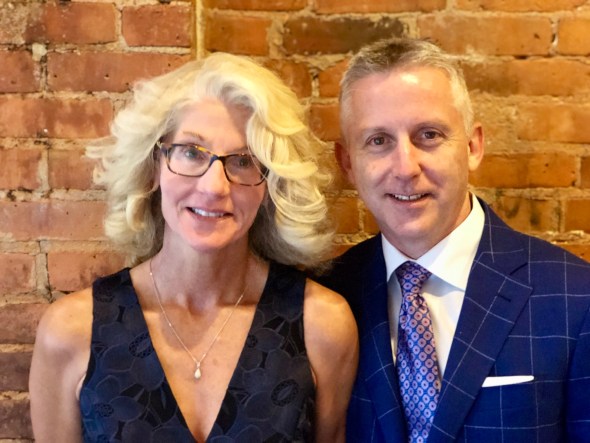He tried to retire at 48. It didn’t stick.

At the age of 48, Stephen Lynch tried to retire.
“I thought I was done,” he says. His retirement lasted three weeks.
The Northeastern graduate had spent nearly 20 years growing a small energy company into a multimillion dollar business, but he still had more to do.
“Why do pro football players go on to sports broadcasting? They love the game. I love the energy space,” Lynch says.
Lynch’s “space” is energy efficiency and demand response, which helps customers reduce and manage their consumption during peak hours and times of high stress on the electric grid, and get paid for using less. In 2001, he co-founded Energy Curtailment Specialists, a pioneer in an industry that’s gained momentum as demands on the country’s electric supply have intensified.

Ann and Stephen Lynch. Photo courtesy Stephen Lynch
But by 2013, Lynch thought he was ready to call it a day. He sold his company to NRG Energy, a large U.S. energy provider and Fortune 500 giant. Three weeks later, just as he was settling into life as a retiree, the buyers gave him a call and invited him for a steak dinner. They wanted to know if he’d come back and form a technology company.
He didn’t take much coaxing. Lynch formed Intellastar, an Internet of Things technology company that produces a smart device to monitor and control energy consumption and communicate it back to NRG’s control central via cellular communication.
“I have a strong work ethic,” says Lynch, who lives in Buffalo but is quarantined in his second home in Naples, Florida. “It’s just the way I was brought up.”
He grew up in Hopkinton, Massachusetts, the youngest of five siblings, all of whom graduated from Northeastern, as did two sisters-in-law and a niece. (Lynch’s two sons and a nephew are currently at Northeastern, studying engineering.)
His father worked for more than 40 years for Prudential insurance company, managing their facility. Neither of his parents went to college; his father “worked his butt off,” Lynch recalled. They were a close-knit family who loved sports, especially football.
But that game had a tragic outcome for Lynch’s older brother Patrick, who played high school football. In his senior year he was playing defense, went to make a tackle, and broke his neck. He was hospitalized for months and told he’d never walk again.
Lynch says his brother’s accident was the most formative event of his life. “Never once did anyone in the family ever see him cry,” he says. “He never took it as a handicap. I don’t even think of him in a wheelchair.” Patrick, who hoped to be a doctor, was accepted to Northeastern in 1977 taking pre-med classes.
By his own account Lynch was an indifferent student in high school, though outgoing and sociable. “I majored in social activities,” he says. “It came in handy later in my business career but didn’t prepare me for college.” His mother doubted he was college material, but his siblings pushed back. “We said, ‘No, he’s going like the rest of us’,” said Patrick.
He did well enough to get into Northeastern, and hoped to study political science. His siblings nixed it, saying they wouldn’t lend him money for school unless he majored in something technical, like engineering.
He did. The first week or two of his freshman year was a bit of a shock. Patrick, who by now was at the University of Massachusetts Medical School in Worcester, was the one who challenged him to apply himself, and Stephen ended up on the Dean’s List.
“Patrick told me that Friday night I should take the bus from Boston to Worcester and study with him for the weekend,” Lynch says. With no friends or distraction, it was a game changer.
“I honestly think my success at Northeastern was seeing Patrick’s discipline, especially given what he was facing,” says Lynch. Patrick is now a radiologist near Syracuse, New York. “He was my inspiration in life. I grew a very large business, but I give a lot of the credit to Patrick. I always tell him he’s my idol, and he laughs at me. Which I think is very mean, to laugh at your younger brother.”
The day after graduation in 1989, Lynch went to work at General Dynamics in Groton, Connecticut in the division that made nuclear submarines. Three years later he moved to Niagara Falls, New York, and became general manager of Ceres Corporation, a manufacturer of cubic zirconia. In 2001 he switched to the energy efficiency and demand response field.
“Steve is an oddity among engineers,” says Steve Moffitt, president of one of NRG’s divisions. “He is very analytical but also relates to people and can read people and is very caring and good at building relationships. He has a good business sense. That’s not so common with engineers.”
One thing Lynch does not talk about much is his philanthropy, which is extensive, according to his family.
“I think he certainly feels blessed and is very generous with what he has,” says Tom Lynch.
“He’s always reaching out to help someone whether he knows them or not,” says his sister Mary Beth Allen. “One time he got pulled over by a cop and when he saw his name, he says, “You’re Steve Lynch? Thank you for all the things you do for the community.”
Among other projects, Lynch is on the board of the Make-A-Wish Foundation of Western New York; he’s helped raise more than a million dollars for that cause. Though eager to talk about his work, he’s evasive when asked about his generosity.
“I like to give back,” he says. “Let’s leave at that.”
For media inquiries, please contact media@northeastern.edu.





